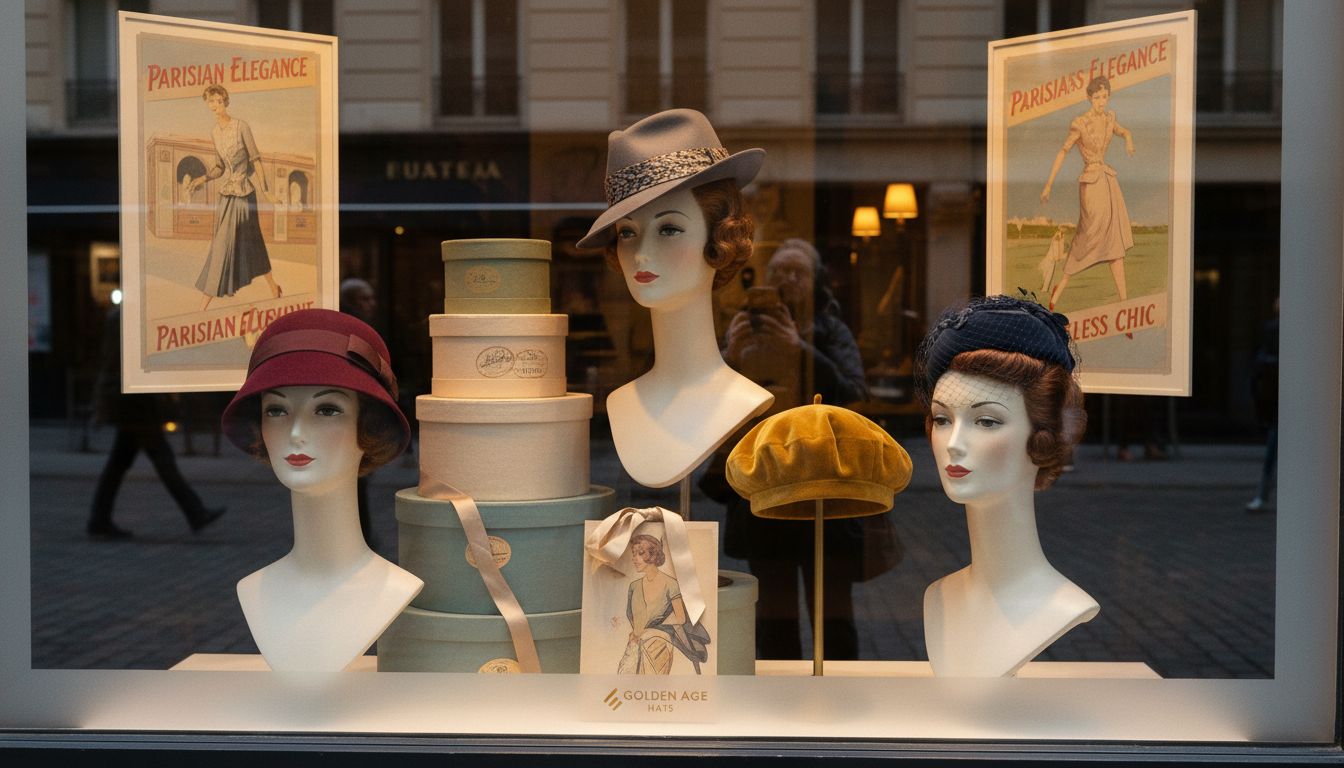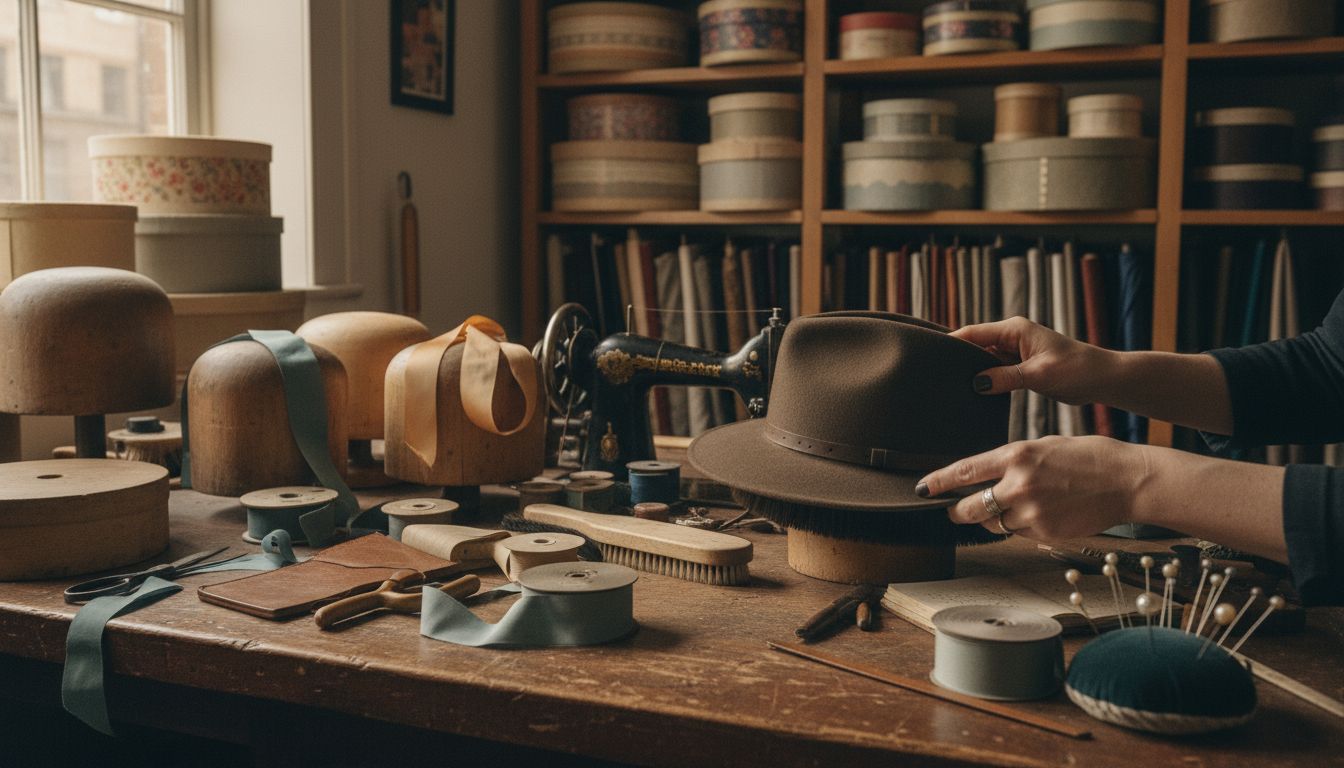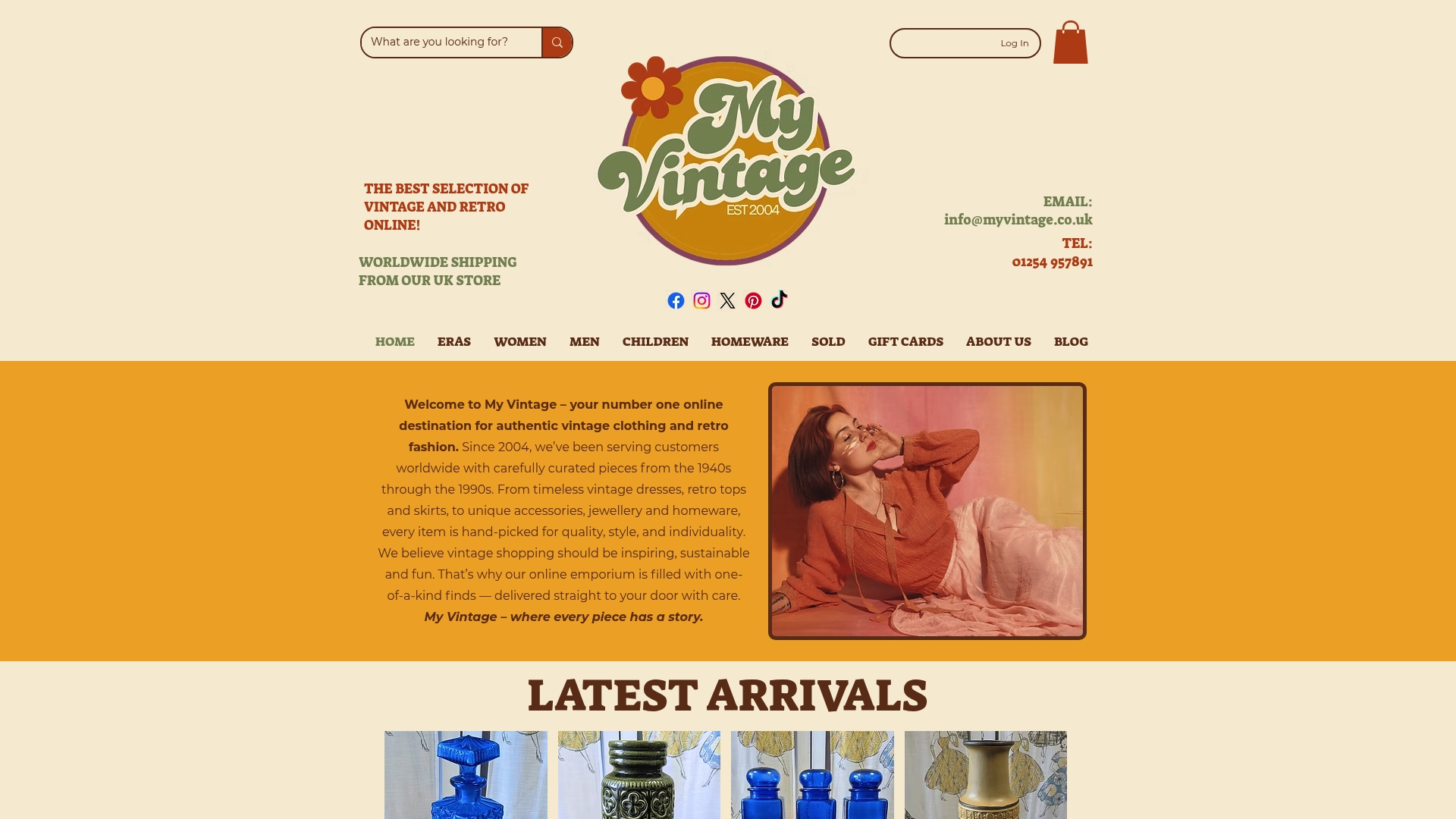Complete Guide to Vintage Hats and Their Legacy
- Emma

- Oct 27
- 8 min read

Did you know that demand for vintage hats has soared by over 35 percent in recent years? These unique accessories carry more than just style, they preserve moments from history and showcase exceptional craftsmanship rarely found today. Whether you admire elegant cloche hats from the 1920s or bold pillbox designs from the 1960s, discovering vintage headwear opens a world of artistry and inspiration for fashion lovers.
Table of Contents
Key Points
Point | Details |
Cultural Significance | Vintage hats are not merely fashion items; they encapsulate historical narratives and social movements from their respective eras. |
Styling Versatility | These hats can enhance modern outfits by adding a touch of retro charm, making thoughtful pairing essential for a sophisticated look. |
Care and Preservation | Proper storage and maintenance are crucial to preserve vintage hats, preventing damage and ensuring their longevity as cultural artifacts. |
Authenticity | Understanding the craftsmanship and materials that define true vintage hats is key to appreciating their historical and aesthetic value. |
Defining Vintage Hats and Their Appeal
Vintage hats represent far more than simple fashion accessories – they are wearable pieces of cultural history that capture the essence of bygone eras. According to Fashion Spotlight - Vintage Hats, these headwear pieces embody the design aesthetics, social movements, and creative spirit of their respective decades, transforming an ordinary outfit into a statement of personal style and historical appreciation.
What distinguishes vintage hats is their exceptional craftsmanship and unique design elements that modern mass-produced accessories often lack. Each hat tells a story – from the structured cloche styles of the 1920s to the dramatic wide-brimmed designs of the 1950s.

As research from Homes and Antiques indicates, their appeal lies in their ability to “reflect the fashion trends and cultural influences of their respective eras”, offering wearers a distinctive accessory that transcends contemporary fashion trends.
The versatility of vintage hats makes them extraordinary wardrobe additions. Whether you’re looking to add a touch of retro glamour to a contemporary outfit or aiming to fully embody a specific historical aesthetic, these timeless pieces provide endless styling opportunities. From elegant silk fascinators to structured wool fedoras, vintage hats allow fashion enthusiasts to express individuality while paying homage to design traditions that have shaped global style.
For those eager to explore more about integrating these remarkable accessories into modern wardrobes, check out our guide on styling vintage hats for expert tips and inspiration.
Iconic Styles Across the Decades
Vintage hats represent a fascinating journey through fashion history, with each decade introducing distinctive styles that reflect the era’s cultural zeitgeist. According to research from Homes and Antiques, the 1920s revolutionized headwear with the introduction of the cloche hat – a bell-shaped design perfectly complementing the era’s iconic bobbed hairstyles, symbolizing the emerging independent spirit of women during the Jazz Age.
As fashion evolved, so did hat styles. The 1930s saw the revival of the elegant toque, worn dramatically to the side of the head, while the felt fedora gained popularity, largely influenced by Hollywood stars like Greta Garbo. By the 1940s and 1960s, functional yet stylish designs like snoods and the iconic pillbox hat emerged, with the latter becoming a signature accessory of Jackie Kennedy and representing sophisticated mid-century American style.
Each decade brought unique hat silhouettes that transcended mere fashion, becoming powerful statements of social change and personal identity.
The beret, originally a working-class cap, transformed into a symbol of artistic rebellion in the mid-20th century, while the structured fedora represented masculinity and urban sophistication. From the playful cloche to the dramatic wide-brimmed designs of the 1950s, vintage hats were never just accessories – they were cultural artifacts that told complex stories of their time.
These remarkable headpieces continue to inspire contemporary fashion, proving that true style is timeless and that a carefully chosen vintage hat can transform any modern outfit with a touch of historical elegance.
Here’s a summary of iconic vintage hat styles by decade:
Decade | Signature Hat Styles | Key Materials | Distinctive Features |
1920s | Cloche | Felt, silk | Bell-shaped Intricate appliqué |
1930s | Toque Fedora Peach Basket | Felt Straw | Worn to the side Hollywood influence Floral ribbons |
1940s | Snood Pillbox | Chenille Felt | Functional Elegant bows Signature of Jackie Kennedy |
1950s | Wide-brimmed styles | Straw Silk | Dramatic silhouettes Decorative trim |
1960s | Pillbox Beret | Wool Felt | Modern, structured shapes Symbol of rebellion |
Materials, Craftsmanship, and Authenticity
The heart of vintage hat collecting lies in understanding the extraordinary craftsmanship that transforms simple materials into wearable works of art. According to research from Homes and Antiques, each era brought its unique material innovations, with the 1920s cloche hats elegantly crafted from felt and adorned with intricate appliqué feathers and diamond clips, representing the pinnacle of artisanal millinery design.
Material selection was crucial in defining vintage hat authenticity. The 1930s saw peach basket hats constructed from delicate straw, often embellished with vibrant flowers and ribbons, while the 1940s introduced functional yet beautiful snoods made from crocheted chenille, decorated with charming bows. Understanding authentic vintage goes beyond mere aesthetics – it’s about appreciating the meticulous techniques and cultural contexts that gave birth to these remarkable accessories.
Vintage hat manufacturers prided themselves on using premium materials like rabbit and beaver felt, ensuring each piece maintained historical accuracy and exceptional quality. These materials weren’t just chosen for durability, but to capture the essence of their respective periods – from the structured felt fedoras of the 1930s to the soft, malleable berets that symbolized artistic rebellion in the mid-20th century.
Today, true vintage hat enthusiasts seek pieces that tell a story through their materials, construction, and intricate details – each hat a testament to the incredible skill of milliners who transformed simple fabrics into extraordinary expressions of personal style and cultural identity.
Styling Vintage Hats for Modern Wear
Reviving vintage hats isn’t about costume play – it’s about making a sophisticated style statement that bridges historical elegance with contemporary fashion. According to recent fashion insights, iconic pieces like fedoras, cloche hats, and berets offer remarkable versatility, seamlessly complementing both formal and casual modern outfits with their timeless design aesthetic.
The key to successfully styling vintage hats lies in thoughtful pairing and confident presentation. A structured 1940s fedora can transform a minimalist blazer and jeans ensemble, while a delicate 1920s cloche can add unexpected sophistication to a contemporary cocktail dress. How to Accessorise Vintage becomes an art form of balancing historical pieces with current trends, creating looks that are simultaneously nostalgic and cutting-edge.
Recent celebrity fashion moments have further validated the enduring appeal of vintage headwear. Marie Claire highlighted Pamela Anderson’s leopard-print pillbox hat – a style reminiscent of Jackie Kennedy – demonstrating how vintage hats can make powerful modern fashion statements. From runway collections at Chloé to street style, these accessories are proving that true style transcends temporal boundaries.
When incorporating vintage hats into your wardrobe, trust your instincts and embrace personal interpretation. Whether you’re pairing a structured beret with a contemporary wool coat or adding a whimsical 1930s wide-brimmed hat to a simple sundress, the most important element is wearing the piece with confidence and individual flair.
Care, Preservation, and Common Pitfalls
Preserving vintage hats requires a delicate balance of knowledge, passion, and meticulous care. According to research from Homes and Antiques, proper storage is paramount – these treasured accessories demand a cool, dry environment away from direct sunlight to prevent fading and material deterioration. The golden rule? Always handle your vintage hats with clean hands and avoid exposing them to moisture, which can irreparably damage even the most resilient fabrics.
Authenticity isn’t just about appearance – it’s about maintaining the integrity of these historical pieces. Understanding the nuances of vintage preservation reveals that each hat requires individual attention. Felt hats, for instance, need gentle brushing to remove dust, while straw or silk pieces demand even more careful handling. Common pitfalls include improper cleaning techniques, storing hats in humid environments, or attempting aggressive restoration that can compromise their original character.
Vintage hat enthusiasts must be vigilant about potential threats. Moth damage, dust accumulation, and improper storage can quickly transform a cherished piece into a damaged relic. Professional conservationists recommend using acid-free tissue paper for stuffing to maintain shape, storing hats in breathable boxes, and avoiding plastic containers that can trap moisture. Temperature fluctuations and direct heat sources are silent destroyers of vintage headwear, so choose storage locations with consistent environmental conditions.
Ultimately, caring for vintage hats is an act of historical preservation. Each carefully maintained piece tells a story – from the intricate 1920s cloche to the bold 1950s wide-brimmed design. By investing time and attention in proper care, collectors ensure these remarkable artifacts continue to inspire and delight for generations to come.
Discover Authentic Vintage Hats That Tell Your Unique Story
Embracing vintage hats means embracing a rich tapestry of cultural history and timeless craftsmanship. If you are inspired by the article’s exploration of iconic styles, materials, and expert care, but find it challenging to locate authentic pieces that reflect personal style and heritage, you are not alone. Many vintage enthusiasts seek hats that are not only striking but also genuine and sustainable, crafted with the attention to detail that modern mass-produced accessories lack.
At My Vintage, we understand the desire to wear vintage hats that connect you to meaningful fashion legacies. Our curated collection features carefully selected hats from key decades, mirroring the story and craftsmanship outlined in the article. Whether you choose a delicate 1920s cloche, an elegant 1940s pillbox, or a bold 1960s beret, you will find pieces that elevate your wardrobe with historical elegance and enduring style.
Elevate your vintage journey today. Explore our entire range of vintage accessories and hats designed for confident self-expression and sustainable style.

Browse the unique selection at My Vintage Hats and Accessories and transform your look with pieces that carry captivating histories. Take the next step in styling your vintage hats with confidence and care. Start your collection now to enjoy authentic vintage charm and timeless flair.
Frequently Asked Questions
What are vintage hats and why are they popular?
Vintage hats are fashion accessories that represent historical fashion trends and craftsmanship from past decades. Their popularity lies in their ability to reflect personal style and cultural history, providing a unique touch to modern outfits.
How can I style a vintage hat for modern wear?
To style a vintage hat, pair it with contemporary clothing that complements the hat’s unique features. For example, a structured fedora can enhance a minimalist outfit, while a cloche hat can add sophistication to a cocktail dress. Embrace personal flair for a balanced look.
What materials are commonly used in vintage hats?
Vintage hats are made from various materials, including felt, straw, silk, and chenille. Each material choice not only defines the hat’s aesthetic but also reflects the craftsmanship and cultural context of its era.
How should I care for and preserve my vintage hats?
To care for vintage hats, store them in a cool, dry place away from direct sunlight. Handle them with clean hands, avoid moisture, and use acid-free tissue paper for support. Gentle cleaning and careful storage can help maintain their integrity and prolong their lifespan.
Recommended








Comments